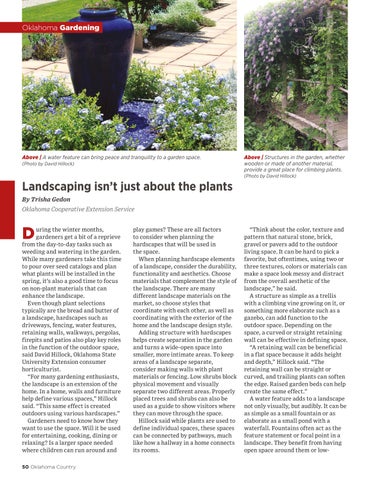Oklahoma Gardening
Above | A water feature can bring peace and tranquility to a garden space. (Photo by David Hillock)
Landscaping isn’t just about the plants
Above | Structures in the garden, whether wooden or made of another material, provide a great place for climbing plants. (Photo by David Hillock)
By Trisha Gedon Oklahoma Cooperative Extension Service
D
uring the winter months, gardeners get a bit of a reprieve from the day-to-day tasks such as weeding and watering in the garden. While many gardeners take this time to pour over seed catalogs and plan what plants will be installed in the spring, it’s also a good time to focus on non-plant materials that can enhance the landscape. Even though plant selections typically are the bread and butter of a landscape, hardscapes such as driveways, fencing, water features, retaining walls, walkways, pergolas, firepits and patios also play key roles in the function of the outdoor space, said David Hillock, Oklahoma State University Extension consumer horticulturist. “For many gardening enthusiasts, the landscape is an extension of the home. In a home, walls and furniture help define various spaces,” Hillock said. “This same effect is created outdoors using various hardscapes.” Gardeners need to know how they want to use the space. Will it be used for entertaining, cooking, dining or relaxing? Is a larger space needed where children can run around and 50 Oklahoma Country
play games? These are all factors to consider when planning the hardscapes that will be used in the space. When planning hardscape elements of a landscape, consider the durability, functionality and aesthetics. Choose materials that complement the style of the landscape. There are many different landscape materials on the market, so choose styles that coordinate with each other, as well as coordinating with the exterior of the home and the landscape design style. Adding structure with hardscapes helps create separation in the garden and turns a wide-open space into smaller, more intimate areas. To keep areas of a landscape separate, consider making walls with plant materials or fencing. Low shrubs block physical movement and visually separate two different areas. Properly placed trees and shrubs can also be used as a guide to show visitors where they can move through the space. Hillock said while plants are used to define individual spaces, these spaces can be connected by pathways, much like how a hallway in a home connects its rooms.
“Think about the color, texture and pattern that natural stone, brick, gravel or pavers add to the outdoor living space. It can be hard to pick a favorite, but oftentimes, using two or three textures, colors or materials can make a space look messy and distract from the overall aesthetic of the landscape,” he said. A structure as simple as a trellis with a climbing vine growing on it, or something more elaborate such as a gazebo, can add function to the outdoor space. Depending on the space, a curved or straight retaining wall can be effective in defining space. “A retaining wall can be beneficial in a flat space because it adds height and depth,” Hillock said. “The retaining wall can be straight or curved, and trailing plants can soften the edge. Raised garden beds can help create the same effect.” A water feature adds to a landscape not only visually, but audibly. It can be as simple as a small fountain or as elaborate as a small pond with a waterfall. Fountains often act as the feature statement or focal point in a landscape. They benefit from having open space around them or low-
